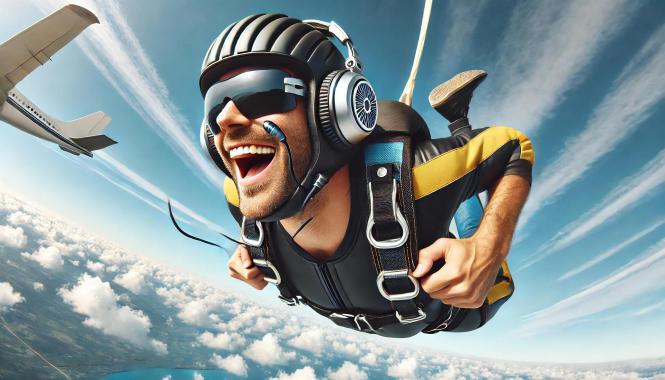
Skydiving remains one of the most thrilling activities that can be done from the comfort of an airplane.
A drop from high altitudes evokes a rush of adrenaline unlike anything else. To many, drone-like sounds of a strumming guitar only enhance and add to these feelings.
Furthermore, it helps maintain calm before the impending leap, focus during the drop, and release of pent-up stress during and after the drop.
No matter what some may choose to believe, safety during these skydives comes first.
When wearing one of the best skydiving helmets available, it is vital to ensure that your music contraption does not block out crucial means of communication.
If you are an advanced skydiving helmet user, follow my six tips that will allow you to jam out while free-falling.
1. Make Sure to get a Helmet that has Music Features
When it comes to strapping on a set of headphones while jumping off a plane, listening devices are not common.
Furthermore, more sophisticated models do come with elements such as Bluetooth or preinstalled communication systems, which enable users to play head-banging music while ensuring focus is not lost.
Steps should be taken to purchase a helmet geared towards advanced skydiving so as to not affect the free fall.
2. Employ Awareness Enhancing Bone Conduction Headphones
Earbuds can be obstructive as they may block surrounding sounds. Without the ability to hear important cues, instructions, or fellow skydivers, traditional music listening approaches may be disruptive.
Because they transduce sound through the cheekbones and sit outside the ears, bone conduction headphones bypass this hurdle.
Through the use of such headphones, essential changes such as shifts of wind or altitude alarms can still be actively monitored even while music is enjoyed.
3. Use Moderated Volume Levels
It may seem exciting to blast skydiving music at maximum volume, but this can be very dangerous.
Dynamic sound levels can easily render one unable to hear signals from the plane, the beeping of the altimeter, or even emergency alerts.
Volume moderation is important to enable one to actively listen to music and, at the same time, be aware of their surroundings.
ALSO READ: 5 Game-Changing Ways Jumbotrons Are Revolutionizing Live Music Shows
4. Improper Securing Of Audio Devices Can Cause Danger
During jumps, loose wires or improperly secured audio devices can pose a risk.
To prevent tangling, it is advisable to use a wireless connection, and where headphones are used, to ensure they are neatly stowed into one’s gear.
In the case of Bluetooth devices, ensure that they are well tethered to thermals such as sweatshirts and helmets to reduce loss midair.
5. Compose an Energetic Collection of Songs
The actual act of skydiving occurs quite quickly. The majority of freefalls last between thirty and sixty seconds.
Rather than listening to an entire album, prepare a short playlist that contains high-energy tracks that bring joy during the time of your jump.
6. Ensure to Check Your Setup Before Jumps
Test the music setup on the ground prior to taking it to the tourist.
Check that the headphones are put correctly under the helmet, the volume is at the right level, and the connections are effective.
Executing a test before boarding allows avoiding technical problems that could hinder your experience.
Conclusion
The use of sound devices while skydiving may improve the experience being undertaken, but utmost attention is to be channeled towards pre-established safety measures.
Utilizing a helmet intended for audio use, using bone-conducting headphones, volume control, and proper device fastening ensures every skydiving enthusiast has their preferred choice of music without endangering themselves.
Following the six points highlighted will guarantee preparation for your next thrilling adventure!

